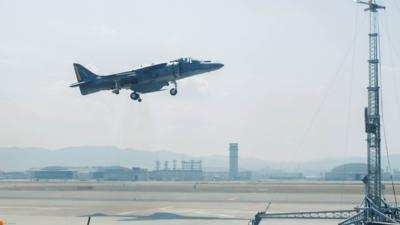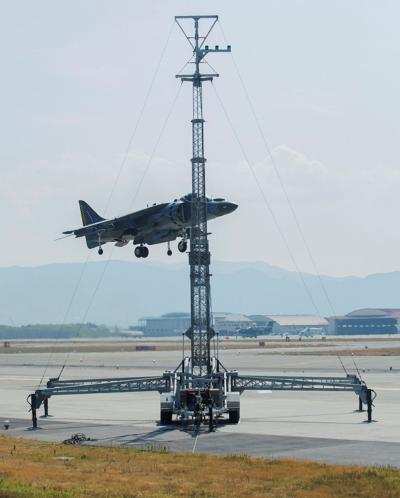Mobile EHPI, Aircraft Recovery Marines Allow For Remote Operations
U.S. Marines with Aircraft Recovery assigned to Headquarters and Headquarters Squadron had an opportunity to train with a mobile version of the Expeditionary Hover Position Indicator at Marine Corps Air Station Iwakuni, Japan, Aug. 9, 2016. Recovery Marines used the indicator to simulate a helicopter dock deck and aircraft carrier landing environment for the AV-8B Harriers to complete their boat landing certification.

The EHPI is normally attached to a structure, but due to the reconstruction of the Harriers recertification site, pilots used the mobile version, which enables shipboard takeoff, landing and oversight for Marines and sailors on deck. The Marines set up the tower-like visual landing aid by hauling it out to the helicopter runway and raising it to provide approach and landing cues for pilots.
“Today we set up the EHPI for the Harriers we have on base,” said U.S. Marine Corps Cpl. William Norkus, a port crew leader with Aircraft Recovery assigned to H&HS. “The Harriers come in for their vertical landings and takeoffs. We have lights up in the sky that tell the pilots if they’re coming in a little too right or too left, if they’re coming in level-perfect, too high or too low and they use the lights to adjust accordingly so they land perfectly.”
The Marines hauled out and set up the EHPI ensuring they had the space to conduct the training and recertification.
“The Harrier pilots are required to maintain a certain set of qualifications wherever they are,” said U.S. Marine Corps Gunnery Sgt. Charles Maddox, staff non-commissioned officer in charge of Aircraft Recovery assigned to H&HS and Expeditionary Airfields section with MWSS-171. “It’s not always a fact that the facilities are set up for them to conduct training, so we had to modify the runway slightly to provide them an area to recertify in those qualifications.”

The EHPI is not a common aircraft recovery tool. Although the indicator is not difficult to use, it still requires training for the Marines on the ground and in the air.
“This piece of equipment is not something they train us for in our military occupation specialty school, this is a special request that came in,” said Norkus. “We got it, trained on it and this is our first time using it just as well as the Harriers’. It’s pretty simple, but it’s an important job to get done.”
Maddox said that the EHPI does not belong to the station but is instead a wing asset.
“It’s the only kind in the world, the only one in the world,” said Maddox. “It was specially delivered to us to assist Marine Aircraft Group 12 in maintaining their qualifications to fly without having to go too far and leave this area of operation to do it, so it gives them the ability to train here on deck.”
Training with the EHPI helps Harrier pilots maintain their qualifications that assist them with LHD deck landings and takeoffs.
“It’s not an easy feat when they don’t do it all the time,” said Maddox. “It’s required for them to receive a certain amount of hours, passes, stops and landings. We use the Expeditionary Hover Position Indicator, which gives them a visual sight reference of where they should land, hover and stop.”
Getting out on the runway to train with the EHPI is significant for the pilots, but also for the crew on the ground.
“It’s really important for the Harrier pilots,” said Norkus. “It’s good training for them right now and for us as well because we don’t get to do this every day.”

Harrier pilots require a facility that accompanies an EHPI about every two weeks for boat-deck landing certification.
“If we go long periods without touching the simulated boat-deck or the boat, then we don’t ever use the EHPI,” said U.S. Marine Corps Capt. Sean T. McHugh, an AV-8B Harrier pilot with Marine Attack Squadron (VMA) 542.
“In this special case, because Iwakuni doesn’t have a tower with a permanent EHPI attached to it, that’s where we required the mobile EHPI’s assistance.”
VMA-542 is home based out of Marine Corps Air Station Cherry Point, North Carolina, forward deployed as part of the unit deployment program at MCAS Iwakuni. They worked with Aircraft Recovery to complete their certification before departing for other future operations in the Pacific. (ANN Salutes Lance Cpl. Donato Maffin for the story).
 Senator Pushes FAA to Accelerate Rocket Launch Licensing
Senator Pushes FAA to Accelerate Rocket Launch Licensing Classic Aero-TV: RJ Gritter - Part of Aviations Bright New Future
Classic Aero-TV: RJ Gritter - Part of Aviations Bright New Future Aero-FAQ: Dave Juwel's Aviation Marketing Stories -- ITBOA BNITBOB
Aero-FAQ: Dave Juwel's Aviation Marketing Stories -- ITBOA BNITBOB ANN's Daily Aero-Linx (10.27.24)
ANN's Daily Aero-Linx (10.27.24) ANN's Daily Aero-Term (10.27.24): Clearance Void If Not Off By (Time)
ANN's Daily Aero-Term (10.27.24): Clearance Void If Not Off By (Time)





